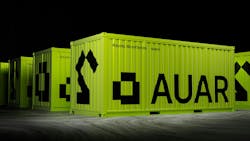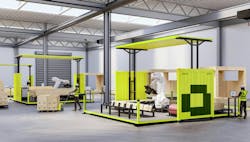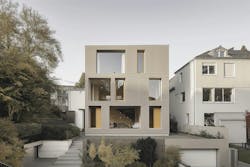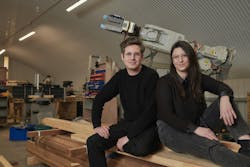These AI Robots Can Help Build Homes
An unfortunate fact of stick-built home construction is that much of the wood ends up wasted. It’s estimated that around 10% to 15% of wood on new construction doesn’t get used—a waste of money and material.
But more efficient factory construction requires large capital expenditures. “Modular construction is an especially capital-intensive approach in an already capital-intensive industry,” according to global management consulting firm McKinsey.
Automated Architecture (AUAR), a London-based construction tech startup, has devised a technology that aims to mitigate the wood-waste problem while also addressing the industry’s skilled-labor shortage—without requiring builders to make a large capital expense.
As part of a hardware-as-a-service model, AUAR has developed what it calls a robotic micro-factory that can help build high-quality sustainable homes at affordable prices. The micro-factories produce modular wood-frame panels for floors, roofs, and walls, which are then assembled onsite.
Using one micro-factory, AUAR says a builder can erect the shell of a wood-frame home in less than 12 hours—without extensive training or knowledge of robotics.
Recently, AUAR shipped two of its robotic micro-factories to the US, the company’s first foray into expanding operations to North America. Each of the two pop-up factories can produce up to 180 homes a year.
With these two factories, Rival Holdings, an Indiana-based real estate development and construction firm, first will build a low-energy accessory dwelling unit. Eventually, Rival Holdings, AUAR’s first customer outside of Europe, intends to use the factories to build thousands of sustainable and affordable homes across the Midwest.
Fully Assembled Robot Included
With a 12-week lead time from ordering to shipping, each micro-factory comes in a standard shipping container with a fully assembled robot.
Manufactured by ABB, a global engineering company with expertise in robotics, the robot starts off by using an automated saw to cut pieces of wood to precise measurements—ensuring accuracy and minimizing waste. The robot then assembles the parts into wood-frame panels. In addition, the micro-factory can create closed wood-frame panels with insulation, as well as external wood façade panels.
Meanwhile, the AI robot, equipped with vision capabilities, performs continuous quality checks.
The robot handles all of the nailing and lifting itself. “Automation enhances health and safety by reducing the risk of injuries on construction sites, as robots handle dangerous tasks and create a safer working environment,” says Mollie Claypool, cofounder and CEO, AUAR.
The robot also can customize the panels. “This means that homes produced by an AUAR micro-factory can be tailored to specific designs and requirements without any changes to the production process,” Claypool says.
After assembly, the panels are transported to the construction site, where they’re put together to form the home’s ceilings, floors, and walls. On site, trades install the mechanical, electrical, and plumbing systems and the finishes.
Throughout the process, AUAR provides remote support via a software platform that automates traditionally manual processes, such as the collection of design requirements, building codes, and supply chain information. The platform automatically generates full design specifications, including construction details, bills of materials, the manufacturing code for the micro-factories, and installation sequencing instructions.
AUAR says its robotic micro-factories decrease the time and labor costs of traditional homebuilding methods, enabling the rapid construction of homes. While reducing the need for skilled labor, the process boosts efficiency, predictability, and oversight.
And less waste means less environmental impact. “The use of robotic precision minimizes waste and optimizes material usage, contributing to more sustainable building practices,” Claypool says.
With its streamlined production process, AUAR enables builders to deliver sustainable housing at a more affordable price, Claypool says. “This automated approach helps to lower construction costs, making homes more affordable for a wider range of people.”
Currently, an AUAR micro-factory can deliver panels for one- to three-story single-family and multifamily homes. By 2026, the company says, its pop-up factories will create panels for up to six-story multifamily projects.





